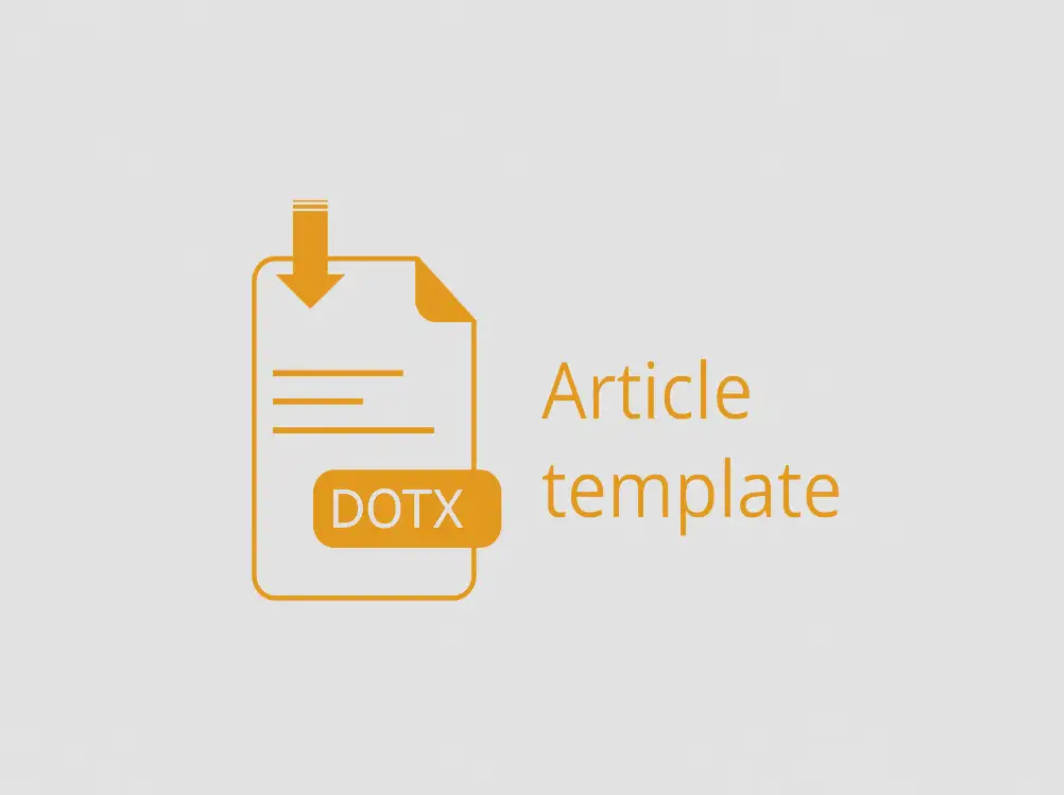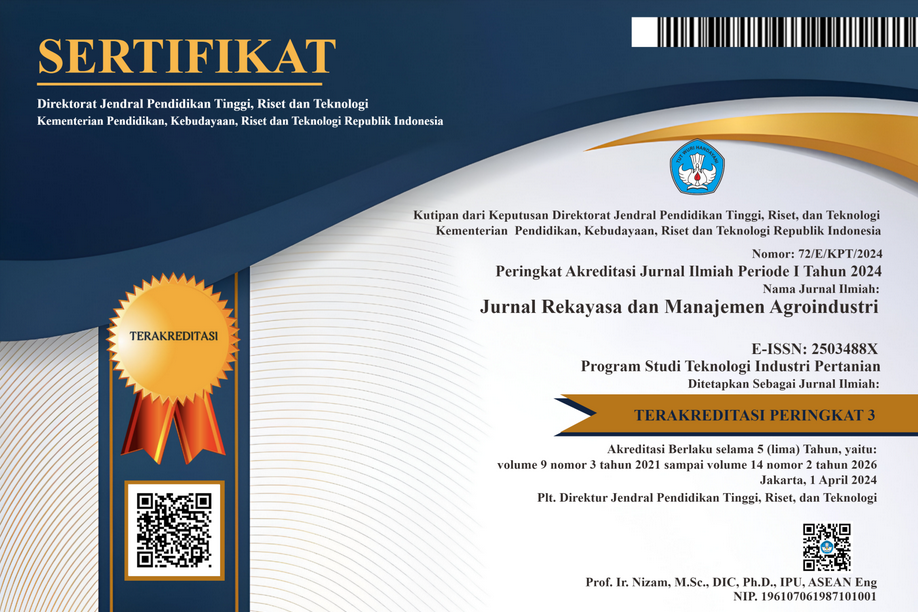Pengaruh Rasio Campuran Surfaktan dan Rasio Campuran Surfaktan Dengan Minyak Atsiri Kenanga (Cananga odorata) Terhadap Karakteristik Mikroemulsi Sebagai Body Mist
Abstract
his study aims to determine the effect of the formulation of the surfactant mixture ratio Tween 80: Tween 20: Span 80 on the characteristics of the microemulsion of ylang ylang essential oil as a body mist, determine the appropriate ratio of the surfactant mixture of Tween 80: Tween 20: Span 80 on the characteristics of the best ylang essential oil microemulsion as body mist, and determine the ratio of the mixture of surfactant and ylang essential oil microemulsion characteristics of the best ylang ylang essential oil as a body mist. This study used a completely randomized design with the factors being a mixture ratio of three surfactants Tween 20, Tween 80, and Span 80. The treatments used were 97:2,75:0,25; 97:2,50:0,50; 97:2,25:0,75; 97:2.00:1.00; and 97:1,75:1,25. The best surfactant mixture ratio is the one with the smallest value. Data were analyzed using ANOVA, if there was a difference, the BNT test was continued. Treatment formulations the ratio of surfactant and ylang ylang essential oil was 90:10; 87.5:12.5; 85:15; 82.5:17.5; and 80:20. The best microemulsion is the one with the highest concentration of ylang ylang essential oil and has a transparent appearance. The best microemulsion was tested for stability against pH and dilution for 8 weeks, observations were made every 2 weeks, and the rate of damage was calculated using linear regression analysis. The results of this study indicate that the ratio of the surfactant mixture Tween 20: Tween 80: Span 80 has an effect on the microemulsion characteristics of ylang ylang essential oil as a body mist. The ratio of surfactant mixture in RS1 (2.75: 97: 0.25) was the best treatment for making ylang ylang essential oil microemulsion as a body mist with microemulsion characteristics that had a transparent appearance. The ratio of the mixture of surfactant and ylang essential oil in the SM4 treatment (82.5: 17.5) was the best treatment to make a microemulsion of ylang-ylang essential oil as a body mist with a turbidity index value (%) before and after centrifugation of 0.415 ± 0.098% and 0.248±0.053%, particle size 17.3±6.3 nm, the largest droplet size was 15.8 nm, a zeta potential value of 0.1mV and stable for 8 weeks of storage.
Keyword: microemulsion, ratio, surfactant, Cananga odorata
Penelitian ini bertujuan untuk mengetahui pengaruh formulasi rasio campuran surfaktan Tween 80: Tween 20: Span 80 terhadap karakteristik mikroemulsi minyak atsiri kenanga sebagai body mist, menentukan rasio campuran surfaktan Tween 80: Tween 20: Span 80 yang tepat terhadap karakteristik mikroemulsi minyak atsiri kenanga terbaik sebagai body mist, dan menentukan rasio campuran surfaktan dan minyak atsiri kenanga karakteristik mikroemulsi minyak atsiri kenanga terbaik sebagai body mist. Penelitian ini menggunakan Rancangan Acak Lengkap dengan faktor adalah rasio campuran tiga surfaktan Tween 20, Tween 80, dan Span 80. Perlakuan yang digunakan 97:2,75:0,25; 97:2,50:0,50; 97:2,25:0,75; 97:2,00:1,00; dan 97:1,75:1,25. Rasio campuran surfaktan terbaik adalah yang memiliki nilai terkecil. Data dianalisis menggunakan ANOVA, bila ada perbedaan dilanjutkan uji BNT.Perlakuan formulasi rasio surfaktan dan minyak atsiri kenanga yaitu 90:10; 87,5:12,5; 85:15; 82,5:17,5; dan 80:20. Mikroemulsi terbaik adalah yang memiliki konsentrasi minyak atsiri kenanga tertinggi dan memiliki kenampakan transparan. Mikroemulsi terbaik diuji stabilitas terhadap pH dan pengenceran selama 8 minggu, pengamatan dilakukan setiap 2 minggu, serta laju kerusakan dihitung menggunakan analisis regresi linier. Hasil penelitian ini menunjukkan bahwa rasio campuran surfaktan Tween 20: Tween 80: Span 80 berpengaruh terhadap karakteristik mikroemulsi minyak atsiri kenanga sebagai body mist. Rasio campuran surfaktan pada perlakuan RS1 (97: 2,,75: 0,25) merupakan perlakuan terbaik untuk membuat mikroemulsi minyak atsiri kenanga sebagai body mist dengan karakteristik mikroemulsi yang memiliki kenampakan transparan. Rasio campuran surfaktan dan minyak atsiri kenanga 82,5: 17,5 adalah mikroemulsi minyak atsiri kenanga terbaik sebagai body mist dengan nilai indeks indeks turbiditas (%) sebelum dan setelah sentrifugasi yaitu sebesar 0,415±0,098% dan 0,248±0,053%. Mikroemulsi minyak atsiri kenanga stabil terhadap pengenceran dengan pH 4,5, pH 5,5, dan pH 6,5 dan pengenceran 1:9, 1:49, 1:99 selama penyimpanan 8 minggu. Ukuran partikel sebesar 17,3±6,3 nm, ukuran droplet terbanyak adalah 15,8 nm, nilai zeta potensial 0,1mV
Kata kunci : Mikroemulsi, rasio, surfaktan, Cananga odorata
Downloads
References
Ariviani, S., S. Raharjo, S. Anggrahini, dan S. Naruki. 2015. Formulasi dan stabilitas mikroemulsi o/w dengan metode emulsifikasi spontan menggunakan vco dan minyak sawit sebagai fase minyak: pengaruh rasio surfaktan-minyak. Agritech. Agritech, 35(1), 27-34.
Armando, R. 2009. Memproduksi 15 Minyak Atsiri Berkualitas. Jakarta: Penebar Swadaya.
Chandra, B. 2008. Metodologi Penelitian Kesehatan. Jakarta: EGC.
Cho, Y. H., S. Kim, E. K. Bae, C. K. Mok, and J. Park. 2008. Formulation of a cosurfactant-free o/w microemulsion using nonionic surfactant mixtures. Journal of Food Science, 73(3), E115-E121.
Cui, J., Yu, B., Zhao, Y., Zhu, W., Li, H., Lou, H., & Zhai, G. (2009). Enhancement of oral absorption of curcumin by self-microemulsifying drug delivery systems. International journal of pharmaceutics, 371(1-2), 148-155.
El-Laithy, H. M. (2003). Preparation and physicochemical characterization of dioctyl sodium sulfosuccinate (aerosol OT) microemulsion for oral drug delivery. aaps Pharmscitech, 4(1), 80-89.
Flick, E.W. 1966. Cosmetics abd Toiletry Formulations, Noyes Publ., Westwood, New Jersey.
Ginting, Z., Ishak, I., & Ilyas, M. (2021). Analisa Kandungan Patchouli Alcohol Dalam Formulasi Sediaan Minyak Nilam Aceh Utara (Pogostemon Cablin Benth) Sebagai Zat Pengikat Pada Parfum (Eau De Toilette). Jurnal Teknologi Kimia Unimal, 10(1), 12-23.
Hatta S. 1993. Budidaya Kenanga. Kanisius Press. 11-12.
Herz, R. 2011. Perfume In: Gottfried JA, Editor. Neurobiology of Sensation and Reward. Francis: CRC Press/Taylor.
Jufri, M., Djajadisastra, J., & Maya, L. (2009). Pembuatan mikroemulsi dari minyak buah merah. Majalah ilmu kefarma-sian, 6(1), 3.
Ketaren, S. 1985. Pengantar Teknologi Minyak Atsiri. Balai Pustaka. Jakarta.
Khalida, N. S., R. Annisa, Y. Y. A. Indrawijaya. 2019. Karakterisasi dan Uji Pelepasan Mikroemulsi Topikal Natrium Diklofenak Menggunakan Virgin Coconut Oil (VCO) Sebagai Fase Minyak. Skripsi. Tidak Dipulikasi-kan.Fakultas Kedokteran dan Ilmu Kesehatan, Universitas Islam Negeri Maulana Malik Ibrahim Malang, Ma-lang.
Lutony, T. L., & Rahmayati, Y. (1994). Produksi dan Perdagangan Minyak Atsiri, Penebar Swadaya. Jakarta
Martin, A., Swarbrick, J., & Cammarata, A. (1993). Farmasi Fisik Jilid 2 Edisi III. Terj. dari Physical Pharmacy, Physical Chemical Principles in the Pharmaceutical Sciences, oleh Yoshita, UI-Press. Jakarta, 940-1010.
Mardliyati, E., Muttaqien, S. E., Setyawati, D. R., & Rosidah, I. Sriningsih.(2012). Preparasi dan aplikasi nanopartikel kitosan sebagai sistem penghantaran insulin secara oral. Prosiding inSINas, 25-30.
McClements, D. J., Decker, E. A., & Weiss, J. (2007). Emulsion‐based delivery systems for lipophilic bioactive compo-nents. Journal of food science, 72(8), R109-R124.
Meva Nareza. 2020. Manfaat Bunga Kenanga untuk Kesehatan. https://www.alodokter.com/manfaat-bunga-kenanga-untuk-kesehatan.
Moghimipour, E., Salimi, A., & Eftekhari, S. (2013). Design and characterization of microemulsion systems for naprox-en. Advanced pharmaceutical bulletin, 3(1), 63.
Norn, V. 2015. Emulsifiers in Food Technology Second Edition. Jhon Wiley and Sons, USA.
Pathan, M., Zikriya, A., & Quazi, A. (2012). Microemulsion: as excellent drug delivery system. International Journal for Pharmaceutical Research Scholors, 1(3), 199-210.
Prasanta, I. P. H. A., Suhendra, L., & Wrasiati, L. P. (2022). Karakteristik Mikroemulsi Minyak Daun Sirih (Piper betle L.) pada Perlakuan Rasio Campuran Surfaktan dan Minyak Daun Sirih. Jurnal Rekayasa Dan Manajemen Agroindustri, 9(4), 582-591.
Pujiarti, R., Widowati, T. B., Kasmudjo, K., & Sunarta, S. (2015). Kualitas, Komposisi Kimia, dan Aktivitas Anti Oksidan Minyak Kenanga (Cananga odorata). Jurnal Ilmu Kehutanan, 9(1), 3-11.
Rachmawati, R. C., Retnowati, R., & Juswono, U. P. (2013). Isolasi minyak atsiri kenanga (Cananga odorata) menggunakan metode distilasi uap termodifikasi dan karakterisasinya berdasarkan sifat fisik dan KG–SM. Kimia Student Journal, 1(2), 276-282.
Rao, J., & McClements, D. J. (2011). Formation of flavor oil microemulsions, nanoemulsions and emulsions: influence of composition and preparation method. Journal of agricultural and food chemistry, 59(9), 5026-5035. https://doi.org/10.1021/jf200094m
Rowe, R. C., Sheskey, P., & Quinn, M. (2009). Handbook of pharmaceutical excipients. Libros Digitales-Pharmaceutical Press.
Rusli, M. 2010. Sukses Memproduksi Minyak Atsiri. Argo Media Pustaka: Jakarta.
Sacchetti, G., Maietti, S., Muzzoli, M., Scaglianti, M., Manfredini, S., Radice, M., & Bruni, R. (2005). Comparative evaluation of 11 essential oils of different origin as functional antioxidants, antiradicals and antimicrobials in foods. Food chemistry, 91(4), 621-632.
Sari, D. K., & Lestari, R. S. D. (2015). Pengaruh waktu dan kecepatan pengadukan terhadap emulsi minyak biji matahari (Helianthus annuus L.) dan air. Jurnal Integrasi Proses, 5(3).
Schoenwald, R. D., & Flnagan, D. R. (1989). Bioavailability of Disperse Dosage Forms. Marcel Dekker Inc. New York, 2, 115-117.
Singh, G. 2010. Plant sistematics an integreted approach: Third edition. Delhi: Science Publishers.
Sucitawati, P. A., Suhendra, L., & Putra, G. G. (2021). Karakteristik Mikroemulsi a-Tokoferol pada Perbandingan Cam-puran Tiga Surfaktan Nonionik dan Lama Pengadukan. Jurnal Rekayasa Dan Manajemen Agroindustri, 9(1), 33-41.
Suhendra, L., Rahardjo, S., Hastuti, P., & Hidayat, C. (2012). Formulasi dan Stabilitas Mikroemulsi O/W sebagai Pem-bawa Fucoxanthin. Agritech, 32(3).
Talegaonkar, S., Azeem, A., Ahmad, F. J., Khar, R. K., Pathan, S. A., & Khan, Z. I. (2008). Microemulsions: a novel ap-proach to enhanced drug delivery. Recent patents on drug delivery & formulation, 2(3), 238-257.
Vaughn, J. M., and Williams, R. 0. 2007. Nanoparticle Engineering. In Encyclopedia of Pharmaceutical Technology, 3rd ed.
Widyarto, A. N. 2009. Uji Aktivitas Antibakteri Minyak Atsiri Daun Jeruk Keprok (Citrus nobilis Lour.) Terhadap Staphylococcus aureus dan Escherichia coli. Skripsi. Tidak Dipublikasikan. Fakultas Farmasi, Univerversitas Muhammadiyah Surakarta.
Wilkonson, J. B. dan R. J. Moore. 1982. Harry’s Cosmeticology. 7th Ed. Chemical Publishing Company, New York.
Yuna, A. P. (2008). Respon pertumbuhan bibit kenanga (Cananga odorata (Lamk) Hook.f. &Thomson forma macro-phylla) pada berbagai intensitas cahaya penggunaan inang primer kriminil dan jenis media (Skripsi). Fakultas Teknologi Pertanian Institut Pertanian Bogor, Bogor.
Ziani, K., Fang, Y., & McClements, D. J. (2012). Fabrication and stability of colloidal delivery systems for flavor oils: Effect of composition and storage conditions. Food Research International, 46(1), 209-216.

Ciptaan disebarluaskan di bawah Lisensi Creative Commons Atribusi-BerbagiSerupa 4.0 Internasional.
Seluruh artikel di Jurnal ini dapat disebarluaskan atas tetap mencantumkan sumber yang syah. Identitas judul artikel tidak boleh dihilangkan. Penerbit tidak bertangggung jawab terhadap naskah yang dipublikasikan. Isi artikel menjadi tanggung jawab Penulis.














